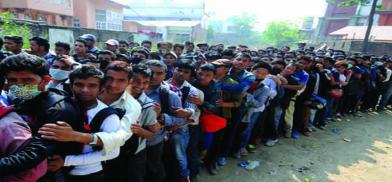Aftermath of COVID-19: Rise of a new social class in Nepal
After the pandemic, migrant workers, including the semi-skilled and skilled labour and small-scale business people, and private job holders, who are returning from abroad, will form the neo-lower class - a new working class - that will constitute a significant population in Nepal, writes Roshan Chirag for South Asia Monitor

Change in society is inevitable. It has taken thousands of years for humans to come to the present era of information and technology from the Stone Age to hunting and gathering to agrarian, to industrial and post-industrial society. The social change of human beings is always driven by new evolution, innovation, and motivation for safety and comfort. Society has its own way of changing but there are some instances and incidents that make society evolve faster. For example, disaster, war, and epidemic/pandemic are some elements that force society to change. The present pandemic situation will also force society to change drastically.
The coronavirus pandemic has impacted almost all the sectors of human life; from economic to social, cultural, and political to spiritual and others. According to the World Bank, the declaration of the pandemic and subsequent lockdown in almost the entire globe could push as many as 60 million people into the ring of extreme poverty. In Nepal, the government has estimated that more than five percent will fall into extreme poverty. Nepal’s population is estimated to be around 30 million. However, thousands of people will be economically downgraded due to joblessness, loans, and price hike.
Rise of a new social class
The economic loss can be recovered sooner or later but the impact it will create on social life will have a long-lasting impact. Social change, which will occur due to the pandemic, will not be easily restored.
The population which will fall down to the poverty level will form a new class in society. The traditional concept of high class, middle class, and lower class will have a new dimension. Now, there will be a new class called the neo-lower class, and which will not be like the lower middle class, because the characteristics of the lower middle class are different. While the lower class has hopes and aspirations for advancement, the neo-lower class has opposite characteristics: less hope, more negativity, and discontent. They retreat from the middle class. The economic status of the lower middle class and the neo-lower class will remain more or less the same, but this new class will be socially more aware, politically more active, and culturally more vigilant than lower-class people.
The neo-lower class is also different from the classical poor class. The classical poor is generally the multi-dimensional poor which has a low income, low awareness, and low access to opportunities.
After the pandemic, migrant workers, including the semi-skilled and skilled labour and small-scale business people, and private job holders, who are returning from abroad, will form the neo-lower class - a new working class - that will constitute a significant population in Nepal. It is estimated that more than 10 million will return back home from the Gulf countries and Malaysia due to COVID-19. The migrant workers in India are also huge and is estimated to be around seven million. Some of them will also return. Their population could be around two to three million.
Migrants will create a new social structure
Migration changes society faster than any conflict, conquest, activism, etc. When people migrate, they don't only migrate physically but they migrate with their culture, ideas, skills, attitudes, and moreover, experiences with them. The amalgam of multiple cultures, ideas, and experiences forms a new society. However, the blending process goes through different layers of conflict. Therefore, in the coming days, we can observe many social conflicts that will bring radical change in Nepal. We are seeing reverse migration from many parts of the globe, mainly from mega-cities of the Gulf countries, India, and other parts of the world. The new class will bring their own customs, culture, and practices, which will create conflict with the indigenous culture and practices of the locals.
The epicenter of migration or let's say reverse migration will be mainly in the urban areas, mostly in the new areas which have emerged over a decade. Many migrant workers have their family already settled in these areas. Not only for better opportunities, better education for their children, but also to get more freedom from their traditional villages and their customs. This new class will then create a new structure in society and introduce new social practices. Change in rituals, marriage practices, festivals, food, culture, lifestyle, and even social greetings will soon surface. The new social structure will be based on the diverse experiences of migrant workers. The practice of nuclear family already exists in Nepal and it will further be strengthened. On the flip side, the rate of divorce, re-marriage, and live-in relationship will see an increase.
It will not be easy for the government to address the aspirations of this rising neo-lower class. Therefore, they will, in the long run, make an impact on the national and local politics of Nepal as well. It will create a new order. Overall, a new social system will emerge in the coming days.
(The writer is an M.Phil student at Kathmandu University School of Education. The views expressed are personal)










Post a Comment